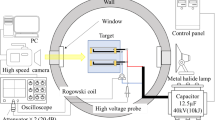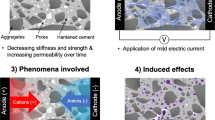Abstract
To evaluate the effect of pulse parameters on the formation of electrodeposits in concrete cracks, five different types of pulse current were set up, and ZnSO4 and MgSO4 solutions were used as the electrolytes. The rate of weight gain, rate of surface coating, rate of crack closure and crack filling depth were measured. Scanning electron microscopy was used to assess the morphology of the electrodeposits, and energy dispersive spectroscopy was used to analyze the mineral composition of the electrodeposits in the cracks. The experimental results demonstrate that, among five different pulse parameters, when Ton/Toff=0.8 ms/0.8 ms, the healing effect of electro-deposition is the best. The pulse mode hardly affects the mineral composition of the electrodeposits but changes the micromorphology. In addition, for both ZnSO4 and MgSO4 solutions, when Ton/Toff=0.8 ms/0.8 ms, the crystal structure of the electrodeposits is the most uniform and the densest.
Similar content being viewed by others
References
Tsyntsaru N, Silkin S, Cesiulis H, et al. Toward Uniform Electro-deposition of Magnetic Co-W Mesowires Arrays: Direct Versus Pulse Current Deposition[J]. Electrochimica Acta, 2016, 188: 589–601
Fan Y, He Y, Luo P, et al. Pulse Current Electro-deposition and Properties of Ni-W-GO Composite Coatings[J]. Journal of The Electrochemical Society, 2016, 163(3): D68–D73
Javadian S, Kakemam J, Sadeghi A, et al. Pulsed Current Electro-deposition Parameters to Control the Sn Particle Size to Enhance Electrochemical Performance as Anode Material in Lithium Ion Batteries[J]. Surface and Coatings Technology, 2016, 305: 41–48
Zelger C, Laumen J, Laskos A, et al. Rota-Hull Cell Study on Pulse Current Zinc Electro-deposition from Alkaline Electrolytes[J]. Electrochimica Acta, 2016, 213: 208–216
Chu H, Jiang L, Song Z, et al. Repair of Concrete Crack by Pulse electro-deposition Technique[J]. Construction and Building Materials, 2017, 148: 241–248
Chu H, Jiang L, Xiong C, et al. Use of Electrochemical Method for Repair of Concrete Cracks[J]. Construction and Building Materials, 2014, 73: 58–66
Ryou JS, Nobuaki Otsuki. Experimental Study on Repair of Concrete Structural Members by Electrochemical Method[J]. Scripta Materialia, 2005, 52: 1123–1127
Chu H, Jiang L, Xu N, et al. Influence of Anion Types on the Electro-deposition Healing Effect of Concrete Cracks[J]. Journal of Wuhan University of Technology -Materials Science Edition, 2012, 27(6): 1154–1159
Yue Lan, Zheng Yu-feng, Sun Yan-fei. Influence of Deposition Current on Structural and Optical Properties of ZnO Films[J]. Semiconductor Optoelectronics, 2007, 28(1): 83–86
Mitra P, Chattejee A P, Maiti H S. Chemical Deposition of ZnO Films for Gas Sensors[J]. Journal of Materials Science, 1998, 9: 441–445
Tohru Yamasaki. High Strength Nanosrystalline Ni-W Alloys Produced by Electrodeposition and Their Embrittlement Behaviors During Grain Growth[J]. Scripta Materialia, 2001, 44: 1497–1502
Ji YL, Guo LN, Xu HB, et al. A Novel Synthesis Route and Phase transformation of ZnO Nanoparticles Modified by DDAB[J]. Journal of Crystal Growth, 2003, 252: 226–229
Zheng C, Zhi WS, Shou X, et al. A Novel and Simple Growth Route Towards Ultra-fine ZnO Nanowires[J]. Journal of Crystal Growth, 2004, 265: 482–486
Ghanbari D, Salavati-Niasari M, Sabet M. Preparation of Flower-like Magnesium Hydroxide Nanostructure and Its Influence on the Thermal Stability of Poly Vinyl Acetate and Poly Vinyl Alcohol[J]. Composites Part B: Engineering, 2013, 45(1): 550–555
Yu JC, Xu A, Zhang L, et al. Synthesis and Characterization of Porous Magnesium Hydroxide and Oxide Nanoplates[J]. The Journal of Physical Chemistry B, 2004, 108(1): 64–70
Jiang W, Hua X, Han Q, et al. Preparation of Lamellar Magnesium Hydroxide Nanoparticles Via Precipitation Method[J]. Powder Technology, 2009, 191(3): 227–230
Author information
Authors and Affiliations
Corresponding author
Additional information
Funded by the National Natural Science Foundation (Nos. 51479051, 51778209, 51609075, and 51508158), the Fundamental Research Funds for the Central Universities (2016B08414), and the National Key R&D Program of China (Nos.2016YFC0401610 and 2016YFC0401804)
Rights and permissions
About this article
Cite this article
Chu, H., Wang, T., Jiang, L. et al. Effect of Pulse Parameters on Deposition in Concrete Crack using Pulse Current Electro-deposition. J. Wuhan Univ. Technol.-Mat. Sci. Edit. 33, 908–914 (2018). https://doi.org/10.1007/s11595-018-1912-y
Received:
Accepted:
Published:
Issue Date:
DOI: https://doi.org/10.1007/s11595-018-1912-y




